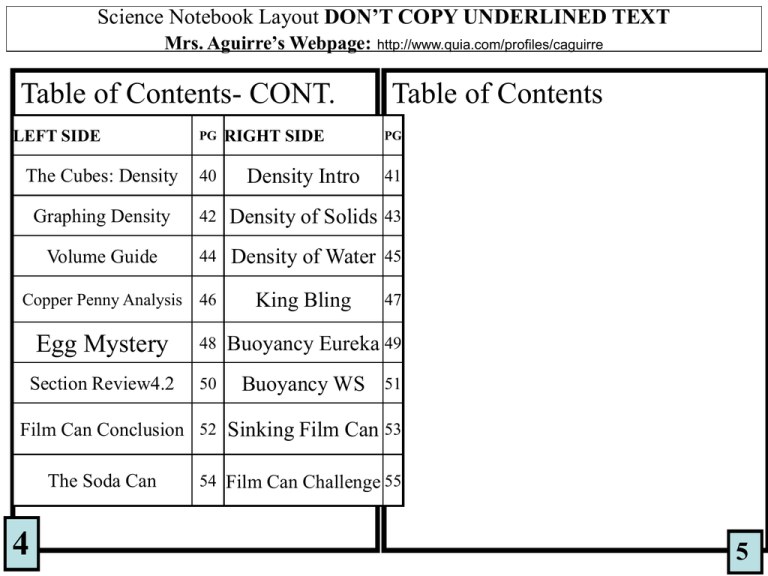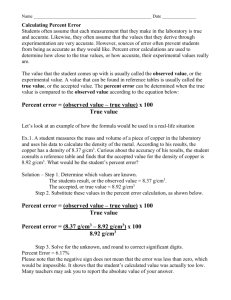Notebook Layout for Density Pages 40-55
advertisement

Science Notebook Layout DON’T COPY UNDERLINED TEXT Mrs. Aguirre’s Webpage: http://www.quia.com/profiles/caguirre Table of Contents- CONT. LEFT SIDE PG RIGHT SIDE Table of Contents PG The Cubes: Density 40 Density Intro 41 Graphing Density 42 Density of Solids 43 Volume Guide 44 Density of Water 45 Copper Penny Analysis 46 King Bling 47 Egg Mystery 48 Section Review4.2 50 Buoyancy Eureka 49 Buoyancy WS 51 Film Can Conclusion 52 Sinking Film Can 53 The Soda Can 4 54 Film Can Challenge 55 5 Science Notebook Layout DON’T COPY UNDERLINED TEXT Mrs. Aguirre’s Webpage: http://www.quia.com/profiles/caguirre Leave blank for now 6 Table of Contents 7 Science Notebook Layout DON’T COPY UNDERLINED TEXT Mrs. Aguirre’s Webpage: http://www.quia.com/profiles/caguirre Introduction to Density 11/7/11 Which weighs more, a pound of feathers or a pound of bricks? Explain. Data Table: Density calculation: Density = Mass/Volume = ___g/ ___cm3 = ____g/cm3 Calculate all densities for cubes on other page using volume found above. Round to nearest hundredth. Include all units as shown in example PVC: D = Mass/Volume Lead ___cm3 = ___g/ = ____g/cm3 Aluminum D = M/V Brass = ___g/ ___cm3 = ____g/cm3 Pine Acrylic Oak 40 D = M/V = ___g/ ___cm3 = ____g/cm3 D = M/V = ___g/ ___cm3 = ____g/cm3 D = M/V = ___g/ ___cm3 = ____g/cm3 Copper D = M/V D = M/V = ___g/ ___cm3 = ____g/cm3 Steel D = M/V = ___g/ ___cm3 = ____g/cm3 Nylon: D= M/V = 18.5g/ 15.625cm3 = 1.184 g/cm3 = ___g/ ___cm3 = ____g/cm3 D = M/V = ___g/ ___cm3 = ____g/cm3 Item Observations Item Observations PVC 26.2 g Lead 163.4 g Aluminum 46.4 g Brass 137.0 g Pine 11.5 g Copper 146.3 g Acrylic 19.5 g Steel 126.2 g Oak 8.9 g Nylon 18.5 g For each item, write three observations- one qualitative and one quantitative. Under the chart, make a list: How they are similar: How they are different: THE CUBES The cubes are similar in: and different in: QuickTime™ and a decompressor are needed to see this picture. VOLUME: Regular shaped solid FORMULA: Volume = L x W x H = __ cm x __ cm x __ cm = 41 Science Notebook Layout DON’T COPY UNDERLINED TEXT Mrs. Aguirre’s Webpage: http://www.quia.com/profiles/caguirre 1. 2. 3. 4. 5. 6. Describe the objects- color, etc Measure Mass with scale in grams. Use the displacement method to find the volume in mL. Graph your data on graph paper. Draw trend line. Calculate the item’s density in g/mL.*** (slope of lineaverage) Use the chart to try to identify what the item is. Density of Solids 11/9/11 Density describes how much mass is in a given volume of a material. Mass is measured by a scale in grams. Volume can be measured by 2 techniques: A) Volume formula (l * w * h) Or B) displacement. Volume Mass Observations (color, texture, size, etc) Volume Mass Observations (color, texture, size, etc) QuickTime™ and a TIFF (LZW) decompressor are needed to see this picture. Copy graph on next page- tape it into your notebook 42 Copy this under the charts. Use 6 lines Density calculations: 1. Density = Mass/Volume = ___g/ ___mL = ____g/mL We think the ________ object is : _____ (describe it) because… (use the chart to try to identify the solids) 43 Example graph of densities- Page 42 Mass (grams) Densities of Solids 45 40 35 30 25 20 15 10 5 0 -5 0 Red Green Silver 5 10 Volume (mL) 15 Densities of items in increasing order 0.64 g/ml 0.75 g/ml 0.77 g/ml 0.90 g/ml 0.92 g/ml 1.15 g/ml 1.17 g/ml 1.23 g/ml 1.32 g/ml 1.37 g/ml 1.42 g/ml 2.2 g/ml 2.7 g/ml 7.7 g/ml 7.9 g/ml 8.56 g/ml 8.91 g/ml 11.3 g/ml Walnut Oak Maple Polypropylene LDPE (polyethylene) Nylon Acrylic Polyurethane Phenolic PVC (Polyvinylchloride) Acetyl Teflon Aluminum Steel Iron Brass Copper Lead Science Notebook Layout DON’T COPY UNDERLINED TEXT Mrs. Aguirre’s Webpage: http://www.quia.com/profiles/caguirre Definition and units to use: (page 78) Amount of water INSTRUCTION MANUAL- To find the volume of: (List steps from p 78 to find the volume of each) 1. LIQUIDS (p.78) a. b. Qu i ck Ti m e ™ an d a de co m pr e ss or ar e n ee de d t o s ee t h is pi ct u re . picture 2. REGULAR SHAPE SOLID a. b. picture c. QuickTime™ and a decompressor are needed to see this picture. 3. DISPLACEMENT METHOD (illustrated) for irregular Solids (use last two paragraphs on P78 to describe and draw the four steps in displacement method.) A. Fill the… B. Slide the object… picture C. What happens? picture WILL DIFFERENT AMOUNTS OF A MATERIAL HAVE DIFFERENT DENSITIES? picture D. How to get volume Density (g/mL) 90 mL 80 mL 70 mL 60 mL 50mL 40 mL 30 mL 20 mL 100 mL The density of the water is the same for each group because….. Density is a ________. As mass increases, volume ______, so when you ______ mass by volume, you get the _____ answer. QuickTime™ and a decompressor are needed to see t his picture. QuickTime™ and a decompressor are needed to see this picture. 44 45 Science Notebook Layout DON’T COPY UNDERLINED TEXT Mrs. Aguirre’s Webpage: http://www.quia.com/profiles/caguirre Copper Density Analysis Calculations: MUST include: Show all math in calculating Comparisons to show if pennies are made of copper List formulas and make calculations for density of 1. Pennies 2. Copper (see NB 40) Analysis: In a paragraph, give a logical answer to the problem: “Are the pennies copper?”. Include your reasons and all quantitative data to support your analysis. Use your density of copper from NB pg 40 to solve the problem Must include: - Are the pennies copper? - Supporting evidence - Recommendations for what King Bling should do. 46 King Bling and the Copper Caper Problem: Are pennies made of copper? My job: skip 2 lines Plan: Group decides how to solve the problem using your knowledge of density. PLAN must: - be specific (HOW will you measure) be accurate (how will you prove if the pennies are copper) Data: Include graduated cylinder drawings record all data needed Data MUST include- pictures to show how data was obtained and ALL measurements made and information collected DO NOT INCLUDE DENSITY CALCULATIONS HERE 47 Science Notebook Layout DON’T COPY UNDERLINED TEXT Mrs. Aguirre’s Webpage: http://www.quia.com/profiles/caguirre Page 48: The Egg Mystery Page 49: Eureka Buoyancy Notes Use 5 lines. QuickTime™ and a decompressor are needed to see this picture. Draw the egg/ beakers Label at least 3 things Observations (what I see) Inferences (what I think) Use 5 lines. Discuss with your partner and record observations and inferences Write at least 3 for each Write 2 questions you would like answered to help you understand the phenomenon. Use 4 lines ONLY 1. 2. Vector: page 48 An arrow that shows the DIRECTION and MAGNITUDE of a force 48 Small force Bigger force 49 Science Notebook Layout DON’T COPY UNDERLINED TEXT Mrs. Aguirre’s Webpage: http://www.quia.com/profiles/caguirre Section Review 4.2 Page 87 1. The buoyant force on an object depends on the _______ of the object that is underwater. 2. What happens to the buoyant force on an object as it is lowered into water? Why? 3. The buoyant force on an object is equal to the weight of the water it ________________. 4. When the buoyant force on an object is greater than its weight, the object ___________. 5. A rectangular object is 10 centimeters long, 5 centimeters high, and 20 centimeters wide. Its mass is 800 grams. a. Calculate the object’s volume in cm3. b. Calculate the object’s density in g/cm3. c. Will the object float or sink in water? Explain. 6. Solid iron has a density of 7.9 g/cm3. Liquid mercury has a density of 13.6 g/cm3. Will iron float or sink in mercury? Explain. 7. Why is it incorrect to say that heavy objects sink in water? 8. Steel is denser than water and yet steel ships float. Explain. 50 Buoyancy Worksheet QuickTime™ and a decompressor are needed to see this picture. 51 Science Notebook Layout DON’T COPY UNDERLINED TEXT Mrs. Aguirre’s Webpage: http://www.quia.com/profiles/caguirre NB Page 52 12/9/11 The Case of the Sinking Film Can: Analysis and Conclusion 1. Calculate the density of the film can: Density = ------------D = _____ g/ _____ mL D = _______ g/mL Density of water: _________ g/mL Why doesn’t the film can float? 3. DENSITY OF OBJECTS AND LIQUIDS EXPLANATION The film can doesn_t float because..... Include: Drawing of film can (NO VECTORS) Measurements of mass and volume with UNITS Calculation of density Comparison of density of film can and liquid QuickTime™ and a d eco mpres sor are nee ded to s ee this picture. 4. THE BUOYANT FORCE EXPLANATION The film can doesn_t float because..... Include: Drawing of film can with vectors labeled with measurements from lab (1, 2, 3) Buoyant force definition and measurements with UNITS Weight definition and measurement. How does Archimede’s principle apply to the film can? Quic kTime™ and a dec ompres sor are needed to see t his pic ture. 52 The Case of the Sinking Film Can: 12/8/11 Archimedes Principle PREDICT: Will an object that sinks weight the same, less, or more than its weight in air? _______________________________ EXPLAIN?: 1. Weight of the film can (in grams) from spring scale ___ 2. Weight of the film can (in grams) under water (not touching bottom) _____ 3. How much less does the film can weigh under water? This is the buoyant force = __________ GRAMS Show subtraction: _______ - ______ = _____ 4. Volume of film can: (use the displacement can) Repeat the measurement until you get answers that are ver close: ________ mL ______ mL _____mL 5. Weight of the water displaced: _________ 6. Write out Archimedes Principle (Pg 83): ________________ ___________________________________________________________ ___________________________________________________________ __ 7. Use Archimedes Principle to explain why the answer to #3 and #5 shou be about the same 53 Science Notebook Layout DON’T COPY UNDERLINED TEXT Mrs. Aguirre’s Webpage: http://www.quia.com/profiles/caguirre NB Page 54 The Film Can Challenge: 12/13/11 Archimedes Principle 12/12/11 The Soda Can PREDICTION: What will happen when we place a can of soda in Lake Aguirre? _______ predicted that……. because…. In your answer, include: density, mass, volume, buoyancy, weight, vector The Soda Can Why does the regular soda sink and the diet soda floats? In your answer, include: density, mass, volume, buoyancy, weight, vector Draw a labeled picture- include vectors for buoyant force and weight. (hint: look at page 49) The buoyant force on an object in water is equal to the weight of the water displaced. Canister Mass of film can (grams) Volume of water displaced (mL) Weight of water displaced (grams) Buoyant force (grams) SINKS FLOATS Suspended in middle MY JOB: __________________ Analysis and Results: (answer these questions with complete sentences!!) 1. What is the mass of an empty film canister? 2. Did the mass of the canister change at all? Explain. 3. Did the volume of the film canister change at all? Explain. 4. What caused each canister to stay at their level in the water? Explain what caused the canisters to float, sink, or suspend using the term buoyancy. ANSWER In WORDS AND DRAWINGS WITH LABELED VECTORS: DRAW FILM CAN, VECTORS LABELED WITH WORDS & MEASUREMENTS FROM LAB (How does the buoyant force compare to the weight of the displaced water?) Use the words: BUOYANT FORCE, DENSITY, WEIGHT, NET FORCE, FLOAT, SINK, DISPLACED WATER 54 55





